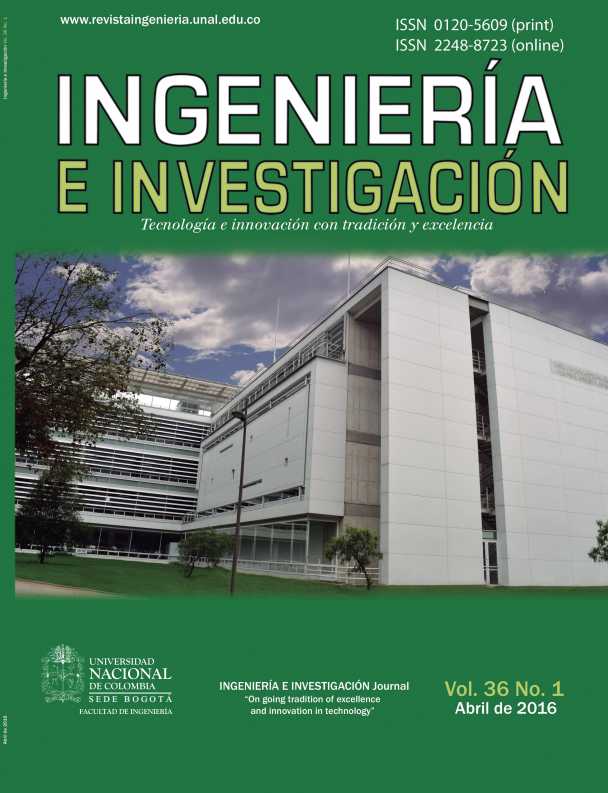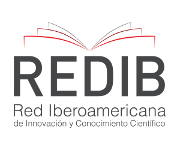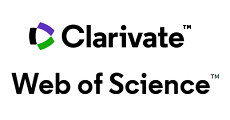State of h5 indicator for Colombian engineering journals
Estado del indicador h5 en revistas colombianas de ingeniería
DOI:
https://doi.org/10.15446/ing.investig.v36n1.56850Keywords:
h5 index, journal impact (en)Downloads
Editorial
State of the h5 indicator for Colombian engineering journals
Upon the implementation of a new model for classifying national journals, different indicators for measuring journal impact are still a topic of discussion. In the most recent editorial note of Ingeniería e Investigación (Pavas, 2015), the classification of colombian journals was presented with respect to the most recognized international indexes.
One of the indicators that has recently gained importance is the h index. This index was proposed by J. E. Hirsch (2005) in order to compare the publications of an individual researcher, and it is defined as “the number of papers with citation number higher or equal to h”. This indicator is widely used by diverse query tools such as Google Scholar1 and the program Publish or Perish (Harzing, 2007). The h index has not only been used for comparing researchers’ productivity, but it has also been employed to compare journals. It can be calculated along specified observation windows, which allows to see the evolution of a researcher or a journal. The h5 index uses a five year long window as a time reference.
Publish or Perish is a free open access program, capable of performing personalized queries on the Google Scholar data base. Google Scholar represents a very important source, as it contains most of the visible open access and free resources, not only the information available in commercial data bases. Using this program, the Colombian engineering journals classified by Colciencias (Publindex, 2014) within the National Bibliographic Index IBN at the second update of 2014 were analyzed according to their h5 index. The indicator was observed over the last five years and was consulted in March, 2016. IBN has currently 4 engineering journals ranked at A1 category and 11 at A2.
Figure 1 shows the evolution of the h5 index for A1 journals (Ingeniería e Investigación, DYNA, Revista Facultad de Ingeniería Universidad de Antioquia and CT&F - Ciencia, Tecnología y Futuro). The indicator decreases with time, which is a natural trend. The average of yearly-based h5 indexes for A1 journals are clearly higher than the average of the A2 journals. This shows that IBN classification permits to differentiate journals according to the worldwide citation level.

Figure 1. h5 index for A1 category IBN journals.
Source: Author
Figure 2 shows a summary of the h5 indexes for A2 journals; due to lack of space, only ISSN codes are included. Despite the fact that some journals can reach h5 indexes equal or higher than h5 indexes of A1 journals, they were categorized as A2. According to Pavas (2015), the main reason for this difference is the presence of A1 journals in international data bases.

Figure 2. h5 index for A2 category IBN journals.
Source: Author.
The quality of a journal should be evaluated following several criteria: editorial quality, periodicity, editorial board, number of published documents, visibility and impact. There is a certain agreement on evaluating impact based on citation levels. Nevertheless, citation is still under debate as it can be adjusted by different means, such as self-citation. On the other hand, low citation levels or high self-citation numbers can be acceptable in certain disciplines. The h5 indicator presented in this editorial note shows that there exists a correlation between the citation level and the results of Colciencias classification. The discussion on impact indicators is still open worldwide.
The Editorial Board of Ingeniería e Investigación is very pleased to present the first number of the 36th volume. We would like to express our appreciation to authors and readers who made this new release possible. We expect the selected papers to be useful and of interest for our readers. Once again, Ingeniería e Investigación encourages authors to share their work.
Andrés Pavas
Assistant Professor
Electrical and Electronic Engineering Department
Director Ingeniería e Investigación Journal
Universidad Nacional de Colombia
References
Hirsch, J. E. (2005). An index to quantify an individual’s scientific research output. Proceedings of the National Academy of Sciences of the United States of America, 102 (46), 16569-16572. http://arxiv.org/abs/physics/0508025
Harzing, A.W. (2007) Publish or Perish, available from http://www.harzing.com/pop.htm
Pavas, A. (2015). Editorial. Ranking of Colombian scientific journals: Engineering case Ingeniería e Investigación, 35(3), 3-4. http://www.revistas.unal.edu.co/index.php/ingeinv/article/view/54609/54655
Publindex. (2014). Índice Bibliográfico Nacional – IBN Publindex, II Actualización. Recuperado de: http://publindex.colciencias.gov.co:8084/publindex/EnIbnPublindex/resultados.do
Editorial
Estado del indicador h5 en revistas colombianas de ingeniería
Ad portas de la implementación de un nuevo modelo de clasificación de revistas a nivel nacional, los distintos indicadores de medición de impacto de revistas siguen siendo un tema de discusión. En la carta editorial más reciente de Ingeniería e Investigación (Pavas, 2015), se presentó la calificación de las revistas colombianas con respecto a los índices de mayor reconocimiento a nivel internacional.
Uno de los indicadores que ha ganado importancia recientemente es el índice h. El índice h fue propuesto por J. E. Hirsch (2005) para comparar las publicaciones de un investigador individualmente, y se define como “el número de artículos con número de citas mayores o iguales que h”. Este indicador se ha usado ampliamente en diversas herramientas de consulta como Google Scholar1 y el programa Publish or Perish (Harzing, 2007). El indicador h se ha empleado no solamente para comparar la productividad de investigadores, pero también para comparar revistas; puede calcularse en ventanas de observación específicas, lo cual permite ver la evolución de un investigador o una revista. El índice h5 usa una venta de cinco años como tiempo de referencia.
Publish or Perish es un programa gratuito de acceso abierto, capaz de realizar consultas personalizadas en la base de datos de Google Scholar. Google Scholar representa una fuente muy importante, puesto que contiene los recursos gratuitos y de acceso abierto más visibles, no únicamente la información disponible en bases de datos comerciales. Usando este programa, se analizaron las revistas colombianas de ingeniería clasificadas como A1 y A2 por Colciencias (Publindex, 2014) en el Índice Bibliográfico Nacional – IBN, en la segunda actualización de 2014 de acuerdo con su índice h5. El indicador fue observado para los últimos 5 años y fue consultado en marzo de 2016. El IBN tiene actualmente 4 revistas de ingeniería en categoría A1 y 11 revistas en A2.
La Figura 1 muestra la evolución del indicador h5 para las revistas A1 (Ingeniería e Investigación, DYNA, Revista Facultad de Ingeniería Universidad de Antioquia y CT&F - Ciencia, Tecnología y Futuro). El indicador se reduce en el tiempo, lo cual es una tendencia natural. El promedio de los índices h5 anuales de las revistas A1 es claramente mayor que el promedio de las revistas A2. Esto demuestra que el IBN permite diferenciar las revistas de acuerdo con su citación a nivel mundial.

Figura 1. Índice h5 para revistas categoría A1 del IBN.
Fuente: El Autor.
La Figura 2 muestra un resumen del índice h5 para las revistas A2; por cuestiones de espacio se incluyen únicamente los códigos ISSN. A pesar de que algunas revistas pueden tener índices h5 iguales o superiores a los índices h5 de las revistas de categoría A1, fueron categorizadas como A2. De acuerdo con lo expuesto por Pavas (2015), la principal razón para esta diferencia es la presencia de las revistas A1 en bases de datos internacionales.

Figura 2. Índice h5 para revistas categoría A2 del IBN.
Fuente: El Autor.
La calidad de una revista debería evaluarse de acuerdo con el seguimiento de varios criterios: calidad editorial, periodicidad, comité editorial, número de documentos publicados, visibilidad e impacto. Hay cierto acuerdo en evaluar el impacto recurriendo al nivel de citación. No obstante, la citación sigue suscitando debate ya que puede ajustarse por distintos medios, como la autocitación. Por otra parte, niveles de citación bajos o autocitaciones altas pueden ser aceptables en ciertas disciplinas. El indicador h5 presentado en esta nota editorial muestra que existe correlación entre el nivel de citación y los resultados de la clasificación de Colciencias. La discusión sobre los indicadores de impacto está abierta todavía en todo el mundo.
El equipo editorial de Ingeniería e Investigación se complace en presentar el primer número del volumen 36. Agradecemos a los autores y a los evaluadores que hicieron posible esta nueva entrega. Esperamos que los trabajos seleccionados sean de utilidad e interés para los lectores. Ingeniería e Investigación extiende nuevamente la invitación a seguir compartiendo sus trabajos.
Andrés Pavas
Profesor Asistente
Departamento de Ingeniería Eléctrica y Electrónica
Director Revista Ingeniería e Investigación
Universidad Nacional de Colombia
Referencias
Hirsch, J. E. (2005). An index to quantify an individual’s scientific research output. Proceedings of the National Academy of Sciences of the United States of America, 102 (46), 16569-16572. http://arxiv.org/abs/physics/0508025
Harzing, A.W. (2007) Publish or Perish, available from http://www.harzing.com/pop.htm
Pavas, A. (2015). Editorial. Ranking of Colombian scientific journals: Engineering case Ingeniería e Investigación, 35(3), 3-4. http://www.revistas.unal.edu.co/index.php/ingeinv/article/view/54609/54655
Publindex. (2014). Índice Bibliográfico Nacional – IBN Publindex, II Actualización. Recuperado de: http://publindex.colciencias.gov.co:8084/publindex/EnIbnPublindex/resultados.do
How to Cite
APA
ACM
ACS
ABNT
Chicago
Harvard
IEEE
MLA
Turabian
Vancouver
Download Citation
CrossRef Cited-by
1. Andres Pavas. (2017). Progress and recent novelties of Ingeniería e Investigación Journal. Ingeniería e Investigación, 37(2), p.3. https://doi.org/10.15446/ing.investig.v37n2.66566.
2. Andrés Pavas. (2017). Are there chances of improving Colombian engineering journals rankings?. Ingeniería e Investigación, 37(3), p.3. https://doi.org/10.15446/ing.investig.v37n3.69519.
3. Andres Pavas. (2018). What are the differences between engineering journal performances?. Ingeniería e Investigación, 38(1), p.3. https://doi.org/10.15446/ing.investig.v38n1.71250.
Dimensions
PlumX
Article abstract page views
Downloads
License
Copyright (c) 2016 Andres Pavas

This work is licensed under a Creative Commons Attribution 4.0 International License.
The authors or holders of the copyright for each article hereby confer exclusive, limited and free authorization on the Universidad Nacional de Colombia's journal Ingeniería e Investigación concerning the aforementioned article which, once it has been evaluated and approved, will be submitted for publication, in line with the following items:
1. The version which has been corrected according to the evaluators' suggestions will be remitted and it will be made clear whether the aforementioned article is an unedited document regarding which the rights to be authorized are held and total responsibility will be assumed by the authors for the content of the work being submitted to Ingeniería e Investigación, the Universidad Nacional de Colombia and third-parties;
2. The authorization conferred on the journal will come into force from the date on which it is included in the respective volume and issue of Ingeniería e Investigación in the Open Journal Systems and on the journal's main page (https://revistas.unal.edu.co/index.php/ingeinv), as well as in different databases and indices in which the publication is indexed;
3. The authors authorize the Universidad Nacional de Colombia's journal Ingeniería e Investigación to publish the document in whatever required format (printed, digital, electronic or whatsoever known or yet to be discovered form) and authorize Ingeniería e Investigación to include the work in any indices and/or search engines deemed necessary for promoting its diffusion;
4. The authors accept that such authorization is given free of charge and they, therefore, waive any right to receive remuneration from the publication, distribution, public communication and any use whatsoever referred to in the terms of this authorization.



























